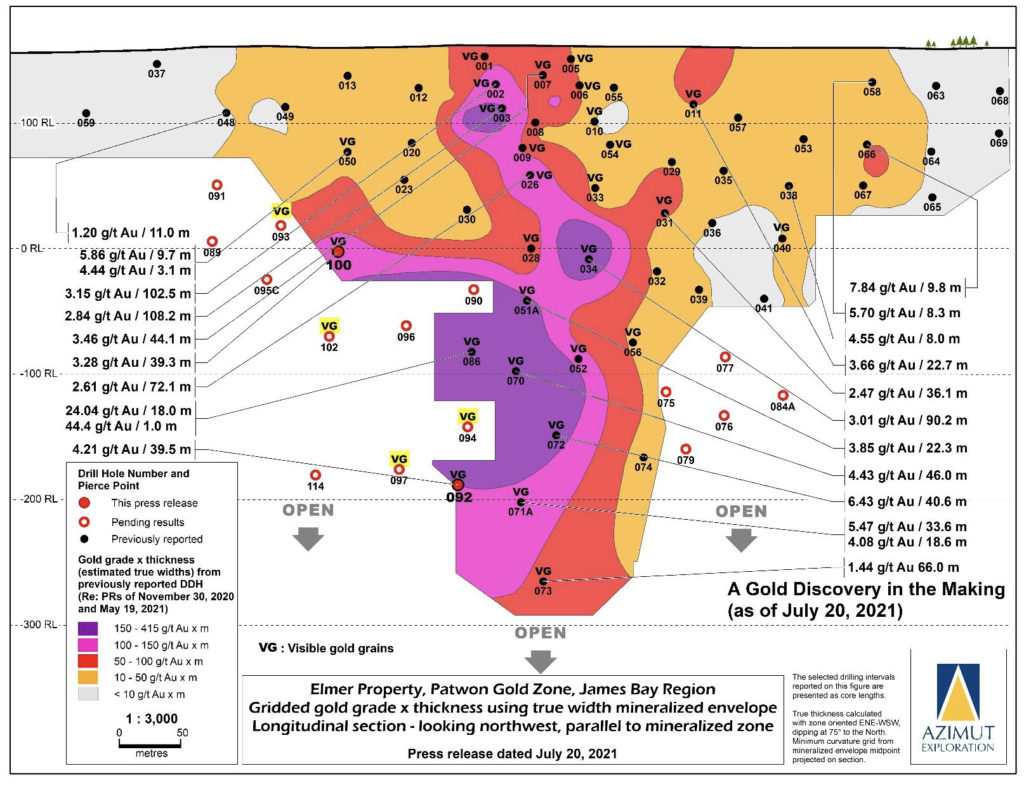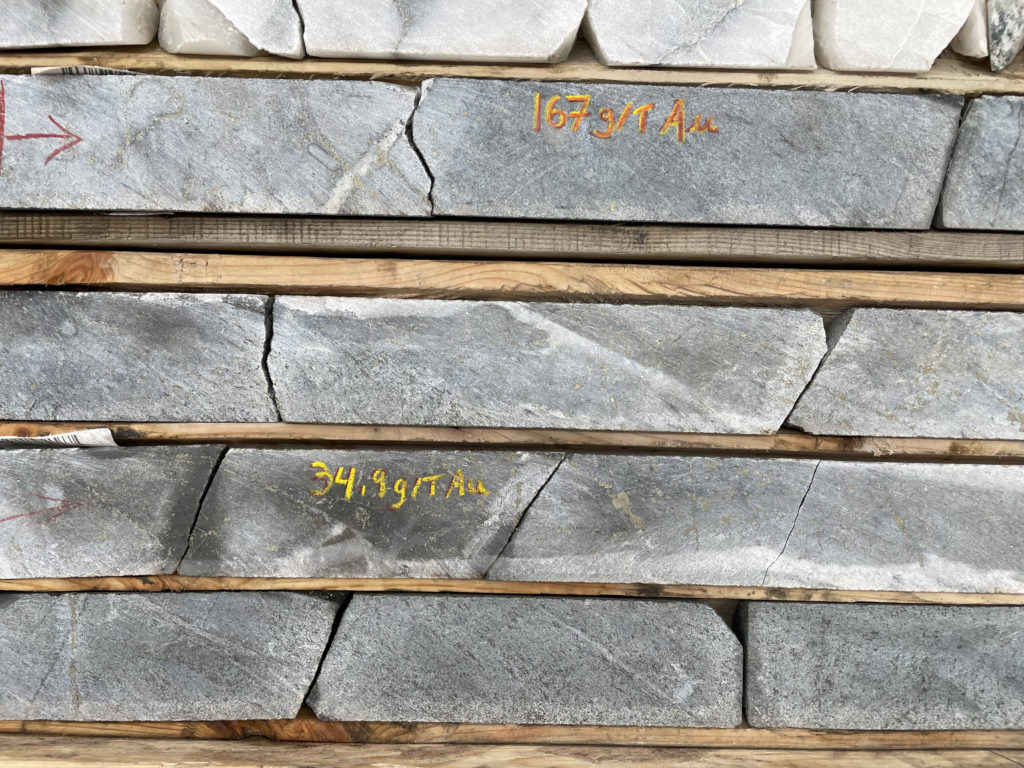Quebec-focused project generator Azimut Exploration (TSXV: AZM) expects the mineralized intrusion underpinning the Patwon discovery of 2019 to widen and increase in grade at depth, president and CEO Jean-Marc Lulin tells The Northern Miner.
“There was plenty of visible gold evident in the core samples recovered from the June drill program, but for which results remain outstanding,” Lulin said on a recent sponsored site visit to the flagship Elmer property in the province’s remote James Bay region.
It could even be that the company’s drills are closing in on a second intrusive, but until the company receives the assay results from backed-up laboratories, it would remain hard to tell. Further drilling remains halted in anticipation of the results.

Azimut continues to wait with heightened anticipation for assay results from several important drill holes, some of which contained visible gold. Credit: Azimut Exploration.
According to Lulin, the Patwon zone is a consistent, steeply dipping, gold-bearing zone that has been traced over a strike length of 500 metres and to a minimum depth of 450 metres, where the system remains “robust and open,” with a possible gold grade increase with depth. The average estimated actual width is about 35 metres based on the published results from 44 drill holes. True widths can reach up to 80 metres.
“Patwon shows an impressive central core that extends from surface to a minimum depth of 450 metres, with an estimated true width of 50 metres and a grade-by-thickness factor ranging from 50 to 412 (based on true widths),” says Lulin. “The core zone appears to widen to the west and with depth. It correlates spatially with a vertically dipping felsic intrusion, indicating a strong possibility for kilometre-scale vertical extent.”
Patwon is an orogenic gold-bearing system in a three-kilometre-thick sequence of felsic volcanics with porphyritic intrusions, mafic volcanics, polymictic conglomerates and gabbroic sills. This deposit type classically has the potential for kilometre-scale vertical extension.
To date, the team’s understanding of the mineralization is mainly related to quartz-vein networks and their wall rock alteration haloes, with pyrite as the dominant sulphide, occurring as fine-to-coarse disseminations, crosscutting stringers and semi-massive to massive lenses. Alteration comprises pervasive silica, feldspar, sericite, chlorite, carbonate and tourmaline. Native gold grains are frequent.
The team has traced the northwest-southeast-trending mineralized envelope northwards, dipping an average of 75° and is subparallel to the schistosity. “It appears geometrically simple, with no internal folding or crosscutting barren dykes, commonly found in other deposits in the James Bay area,” notes Lulin.
“The preliminary geometry supports the concept of an initial open-pit mining operation. The consistent high-grade component in most holes suggests the potential for an underground mining component as well,” says Lulin.

Jean-Marc Lulin (left) orients a group of analysts at the Patwon Discovery outcrop. Credit: Henry Lazenby
The intensity of quartz veining may be partly controlled by rheologic contrasts between host lithologies (felsic intrusives, felsic volcanics and mafic rocks) within an extensive shear zone.
Initial metallurgical tests indicate potentially excellent gold recoveries through a gravity circuit and cyanide leaching. Patwon is a gold-only system with no unwanted elements, such as arsenic or bismuth.
Back-of-napkin calculations show Azimuth has already identified about one million ounces at substantial grade at Patwon to date.
Barrick Gold (TSX: ABX; NYSE: GOLD) formerly held the Elmer property under option from Eastmain Resources (now Fury Gold Mines (TSXV: FURY; NYSE-AM: FURY)), initially centred around the Duxbury claim, which was later folded into the larger Elmer property.
Lulin says Azimut had noticed strong anomalies in its ‘big data’ analysis and had identified a strong potential to find mineralization there. In 2018, Barrick decided Elmer was too much of an early stage play and dropped it, and Eastmain let the claims lapse.
“We absolutely jumped on it in June 2018 when we discovered the claims had been dropped. We were so convinced about the property’s potential that we retain a 100% interest in the property and have not formed a joint venture with anybody like we’ve done elsewhere in our portfolio,” says Lulin.
He says the prospecting that led the company to the Patwon discovery in 2019 was significantly helped by geochemical analysis of the Duxbury claim.

The Patwon Discovery outcrop from where grab samples have returned 54.6 grams per tonne gold. Credit: Henry Lazenby
According to Lulin, Patwon has been recognized as prospective as early as 1999. Early prospecting returned a grab sample of 10.1 grams per tonne gold in an outcropping quartz vein, but it was not enough to instill a sense of ‘discovery excitement.’
“We then started looking at the wall rocks and got a sample that returned 54.6 grams per tonne, that helped change our opinion of the project a great deal,” says Lulin.
The company released the first grab samples in October 2018, following in 2019 with the results from the first tenor sampling at 200-metre fences. The work resulted in Azimut recognizing a 30-metre mineralized corridor at Patwon. The share price went from 50¢ to $1.50 following the first round of drill results in 2019.
“Grade is important, but the orientation of the mineralization is everything here,” says Lulin.
Since then, the company’s drilling campaigns have generally been focused on expanding the size of the known mineralization. “It’s really good mineralogy for high-grade gold mineralization,” says Lulin.
The wall rocks and the quartz veins make for a continuous mineralized system. “The mineralized envelope is very simple, despite some internal geological complexity in the form of visible gold, lots of pyrites, quartz veining and alteration,” he says. These are the four parameters our drillers use, so they know they are getting into the good stuff.”
Prospecting elsewhere on the property has also returned good counts of pristine gold grains, lending further credence to the company’s thesis on something potentially big.
Preliminary metallurgical testing has confirmed all the gold to be free, and 20% to 25% of the gold can be recovered using gravity processing.
Lulin is convinced the Patwon intrusion cannot exist in isolation. He likens the mineralized occurrence to the first of a potential ‘string of pearls.’
A major frustration for the company is the bottlenecks at laboratories. Lulin says the company is still waiting on many results, impeding management’s ability to plan the subsequent phases of the exploration strategy.
Lulin says there are two parts to the exploration strategy: To expand the Patwon discovery to an exploration target of at least two million ounces, to a depth of about one kilometre.
The company aims at finalizing an NI 43-101-compliant mineral resource statement for Patwon by the end of 2022. To this end, the company has just completed constructing a new core shack at Camp Elmer to accommodate the processing of increased core volumes, given the plan to get three to four drill rigs out to the site for the fall and winter drill programmes.
“We know we’re on track here,” he says. “The next priority is to find the other intrusives. This type of geology often manifests like pearls on a string.”
Despite the Elmer property’s remote location, it has reasonable access to infrastructure. There is about 25 km from hydropower at Eastmain and about 25 km from the Billy Diamond highway. An access road to the Elmer site is in the permitting phase, with two helicopters on standby to transport people and cargo from the nearby La Grande airport.
Further, Lulin says the local Cree First Nation has been very proactive about mineral development in the James Bay region and has demonstrated a high degree of business savvy. To date, three agreements have been signed in connection with the exploration and development of Elmer, with the Cree set to play a significant role in the permanent access road’s construction.
Azimut says it maintains a strong focus on cost control and acquires its assets via staking as a project generator. It has never forked over money to acquire its assets, Lulin says. “This exploration work is pure value creation. For example, every dollar spent on Patwon has thus far delivered value.”

Encouraging drill intercepts on display in the newly built core shack. Credit: Azimut Exploration. Credit: Henry Lazenby
According to Lulin, the priority now is to define the envelope. “We’re focusing on expanding what we already know,” he says.
The next steps on the larger Elmer property entail a till survey, and more prospecting while the team awaits the assay results from the last round of drilling. The team also plans to undertake top-of-bedrock reverse-circulation drilling in the hunt for further ‘smoke’ that may indicate the presence of other intrusives.
Importantly, Lulin explains the orientation of the orebody is critically essential. The team will undertake an orientation survey on the covered Patwon area, comprising 200-to-300-metre line spacing along the Patwon Shear extensions and subparallel zones.
“We already have so many high-grade gold zones, given the little exploration we’ve done, the chances of finding more of the same is really in our favour,” says Lulin.
Analysts got excited about the identification of polygenic conglomerate rocks very close to the Patwon outcrop. Lulin notes the formation is a common feature of renowned gold camps in Kalgoorlie, Australia, and even Newfoundland and Labrador’s emerging Marathon gold camp.
Comparing already known deposits with the Patwon discovery features is a crucial step in supporting the exploration hypothesis and envisioning the upside potential of the discovery, even if each deposit is ultimately different.
Key features of the Goldex deposit, owned and operated by Agnico Eagle Mines (TSX: AEM; NYSE: AEM), correlate with Patwon, Lulin says. The steeply dipping mineralized body has a horizontal length of about 450 metres and is 1.8 km in depth. Goldex, a multi-million-ounce gold mine, is located on the west side of Val-d’Or in the Abitibi region of Quebec.
The mineral reserve and resource statement for the Goldex deposit as of December 31, 2020, comprises proven and probable reserves of 1.1 million ounces of gold in 22.1 million tonnes grading 1.57 grams gold per tonne. The measured and indicated resources entail 1.7 million ounces in 31.6 million tonnes grading 1.66 grams gold per tonne, and inferred resources of 1.2 million ounces in 24.8 million tonnes grading 1.5 grams gold per tonne.
The upside potential is what keeps motivating the Azimut team. Ten new drill targets in an eight-km by three-km corridor are ready to be drill tested. At the same time, the team has identified a further two km of prospective strike comprising high-grade undrilled prospects.
The company has extensive induced polarization anomalies, including high counts of pristine gold grains in the till.
Meanwhile, Lulin provided a brief update on the company’s other core prospect, the world-class Rex copper-gold opportunity in Nunavik. “It is a true crustal-scale anomaly 330 kilometres long and 30 to 50 kilometres wide covering the Rex and Rex South properties.
“This will become a new mineral province,” says Lulin.
In 2021, SOQUEM funded a $4 million exploration program on both properties comprising 49 km of ground geophysics, 2,890 metres over 17 holes of diamond drilling, and channel sampling. The projects (Rex and Rex South) are part of a strategic alliance signed between Azimut and Quebec-government-mandated SOQUEM. Azimut is the operator of the partnership.
The region offers significant potential for critical or strategic commodities by the Quebec and Canadian governments, specifically copper, tellurium, bismuth, tungsten, tin, molybdenum, rhenium, indium, and rare earth elements. The Rex and Rex South properties cover a region considered by Lulin and the team to be a new mineral province with the potential to host large-scale deposits.
Analysts say they believe the Elmer property underpins about 90% of Azimut’s current value. They expect the current upside potential at Patwon is probably priced into the current share price. Still, the announcement of a new major discovery will likely send the shares running higher. The company knows this and is therefore prioritizing about 85% to 90% of its capital spend on Elmer exploration.
Data processing is Azimut’s core business, drawing on the publicly available geological dataset developed by the Quebec government. The province, with its more than 180,000 sq. km. of prospective lands, is unique in making available these extensive datasets for free. Lulin and Azimut have developed the so-called AztechMine platform to analyze the data using a ‘big data’ approach. To date, it has resulted in identifying more than 500 mineral prospects in Quebec.

The Elmer Camp on the shores of Lac Elmer, Quebec. Credit: Henry Lazenby
Azimut has signed 32 partnership agreements to date, including with companies such as Rio Tinto (ASX: RIO; NYSE: RIO), Newmont (TSX: NGT; NYSE: NEM), Iamgold (TSX: IMG; NYSE: IAG), Hecla Mining (NYSE: HL) and SOQUEM.
The company was founded in 1986 and today still only has about 81.7 million shares outstanding, with a float of about 23 million shares, of which about 65% is in control of so-called ‘strong hands.’
Lulin himself holds about two million shares, and he is proud to note the equity has never been consolidated during this timeframe. “We have one of the lowest dilution rates of any junior.”
The company currently has about $30 million in cash.
Azimut shares have gained about 75% over the past 12 months to $2.19 as of September 20, capitalizing it at $179 million.


Be the first to comment on "Azimut’s Patwon appears to be widening at depth"